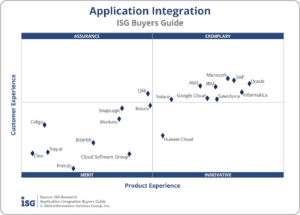
ISG Software Research (formerly Ventana Research) recently published a Buyers Guide for Application Integration, and of the 20 software providers evaluated, Solace was rated as Exemplary with an overall grade of B+.
Solace is thrilled to be placed in the Exemplary quadrant alongside the giants in the application integration landscape.
Criteria
It is important to note that ISG’s vendor evaluations go beyond just product capabilities, and are meant to represent a more holistic view of a vendor’s capabilities to support clients over the long term with their integration initiatives. Vendors were evaluated across 7 criteria: 5 product and 2 provider.
Product Criteria
- Usability: how does it support various roles, devices and generations.
- Manageability: installation, deployment and administration.
- Reliability: delivering on performance and scale.
- Capability: how does it meet the functional needs.
- Adaptability: configuration and customization.
Provider Criteria
- Validation: viability, commitment to the market and products.
- TCO/ROI: demonstrating product value, TCO and total benefit of ownership.
ISG noted in the detailed report that Solace’s top scores came in the Customer Experience categories, particularly in the Validation section where Solace scored B++. This isn’t surprising to us, given the incredibly positive customer reviews we get on review platforms like Gartner Peer Insights and alike. Customer success and satisfaction is a key pillar of Solace’s DNA.
If you would like to read the entire ISG Buyers Guide for Application Integration, you can access it on the ISG website here.
Event-Driven Integration: Turn Your Integration Inside Out
Solace believes sharing data in real-time across applications can best achieved with an event-driven integration approach where data distribution takes place at the core, leaving connectivity and processing to take place at the edge. In essence, event-driven integration turns integration inside out by pushing integration and connectivity to the edge while the event-driven core focuses on moving data across cloud, on-premises and IoT environments and geographies. You can read more about this approach in my colleague’s blog post “How Event-Driven Integration can De-silo our Data and put it in Motion”.
Subscribe to Our Blog
Get the latest trends, solutions, and insights into the event-driven future every week.
Explore other posts from categories: Business | Event-Driven Integration | For Architects | For Developers

 Roger Sabourin
Roger Sabourin
